
At thirteen, I got my first electric. It was not a Gibson, but the Eko resonated (pun intended) Gibson’s archtop guitars and triggered a penchant for visible wood grain and the elegance of f-holes and bound edges. The front cover photo of Eric Clapton on his History album showed him with a full-size Gibson and established that you could be just as cool with that. At that time I hadn’t even heard of Steve Howe.
The sequence of things eludes me now. But in the course of a couple of years I learned about a guy called Les Paul who was an incredible player in spite of an elbow injury and who recorded everything at once. (It was probably told a little differently, but I was thirteen.) Thank you, Uncle Øystein! And my guitar tutor Odd Arne Jacobsen had a Gibson Les Paul, and the sound really got to me.
I have been reflecting on what it is with the sound of a Gibson that feels so appealing. One theory is: Probably the first grown-up song I could really relate to at the age of eight or so was Tennessee Ernie Ford’s version of Sixteen Tons. (Thanks again, Uncle Øystein.) The main instrument is clarinet. The clean sound of a Gibson Les Paul neck humbucker has this mellow, rounded hmmmm timbre that is almost clarinet-like. How about it, Doctor?
I thought a Gibson was beyond me, and got an Epi. Then the collecting gene kicked in and the Special was invited into the family. And then the SG, and finally (or so I thought) a proper Les Paul Sunburst. How wrong was I…
Hollow body, semi-solid, or solidbody. Gibson has always been instrument makers as opposed to Fender’s tool shop approach. Getting the Ibanez copy in 1973 paved way for the growing number of original Gibsons accumulated, and as with Fender I wanted to document the wide range of models through the years. Keeping the mistakes out, of course. No robot tuners, or even worse, Jimi Hendrix models… Sorry for mentioning that. It seems Gibson is back on track; I enjoyed a 2019 Gold Top that proved it until a genuine 70’s model appeared.
1957 hollowbody, newer 135 and 175. Four 335 family members from 1972 to 1979 plus one Artist. I wanted to tell the Les Paul story summary in six guitars; the Junior failed at first (see recent Apprentice acquisition), but there is now a Junior, a Special, a Sunburst, two Deluxes, and a Recording. There is also an SG, and being a broadminded collector, I have included an Epiphone bass and doubleneck in the SG family, and an Orville in the shape of a Custom. If Father Christmas reads this; would you consider a Les Paul Professional?
Gibson Les Paul Special
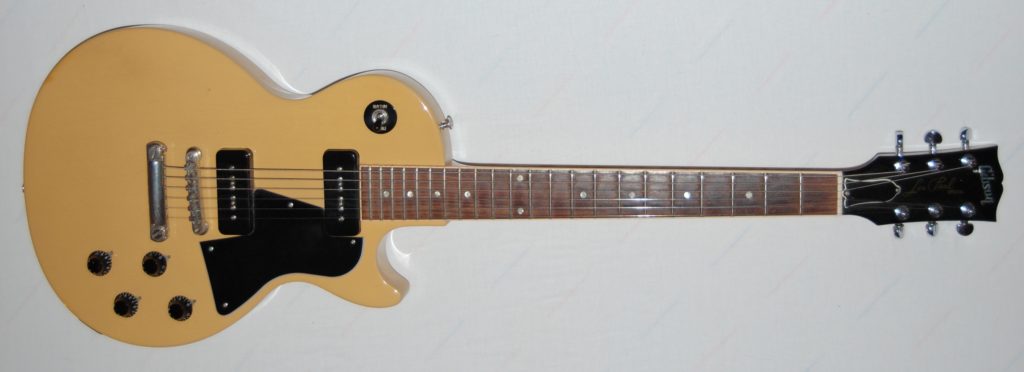
Two P100 humbucking soapbars, all-mahogany flat top, set and bound neck.
Gibson’s mid-version of the Les Paul, between the Junior (one pickup) and the Standard/Custom with arched maple top and PAFs (or successor). Relaunched in the nineties with P100 humbuckers instead of P90 single coils. Various theories try to explain the origin of the “TV yellow” colour – does it look good on b/w TV, or was Les himself a great TV star? No point in arguing, this isn’t a TV, but a Special, even though the colour is the same.
I do not always find what I’m looking for, and maybe that is why I never stop looking. Epiphone’s Goldtop was on my list, but not on offer at Ljosland. But Asle tempted me with an almost mint used Gibson, and financing offered. Sold.
In a way this guitar demands some effort, but it gives plenty back, as opposed to the Joe Pass I once struggled with. Originally it was set up quite high, but that was part of the solid Gibson sound. I have lowered the strings a bit, and have to work my right hand a bit harder to compensate for the easier load on my left fingertips.
The sound is heard on The Ocean, Behind the Monastery at Dawn (duelling with a Tele) and In Time to Change, the heavier parts of Parallel Ride, and frequently on Pictures of Rain.


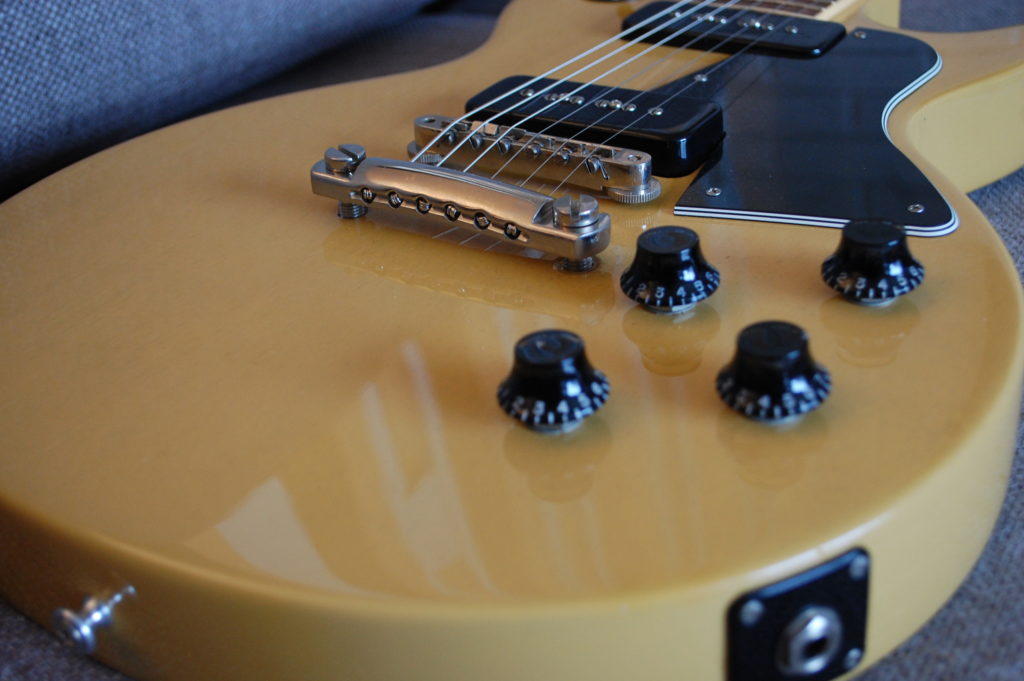


Epiphone 1275

Epiphone Doubleneck 1275 (2003)
U6120341
Twin neck SG shape; six and twelve bolt-on necks. Two humbuckers each, standard Gibson two volume two tone for all output, three-way switch for pickups, three-way switch for necks (meaning you can choose both, as opposed to the Dano, enabling drone sound from one when playing the other).
I have mentioned Epiphone before. Most current Gibson models (and a few classics) come in Epi versions. This is an uncommon edition of a Kalamazoo classic.
Jimmy Page, anyone? Or Steve Howe in the seventies? The practicality of having the jangle on hand, six inches from a very playable SG. The Web led me to Centermusik in Frederikshavn, Denmark, and there it was, right in the middle of the shop, asking politely to be taken home. The Danish counting system is something like Fourscorelesshalfascoreandtwee, but VISA sorted it out for me and charged me £400 or so.
I had a theme already on the Danelectro doubleneck, it made sense to enlist the Epi for jangle and soloing through the eleven minutes needed. Including synth solo, see microKorg.





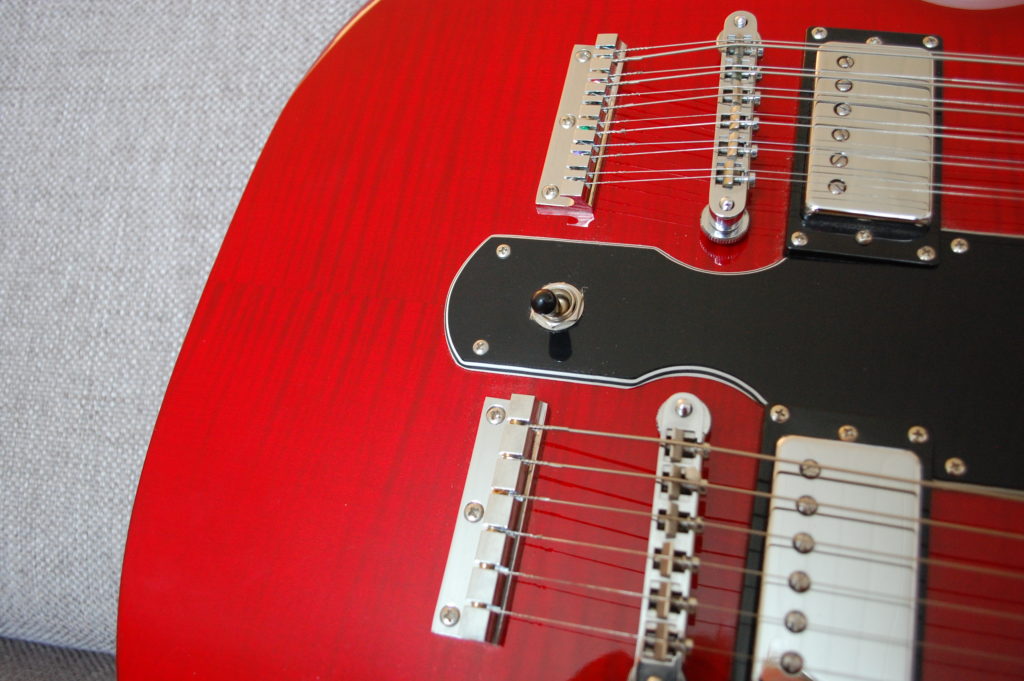

Gibson SG Special

Gibson SG Special 2004 (2005)
02694533
Body and set-neck in mahogany, two uncovered humbuckers, three-way switch and standard two volume, two tone layout. Special refers to unbound dottet fretboard and the lack of pickup covers.
As the Les Paul Sunbursts seemed to fall out of fashion, Gibson tried to think of something new. The name SG for Solid Guitar was self-explaining, but the pointed cutaways did not appeal to everybody. Especially not to Les himself, who opted out. The appeal grew over time, and the SG has received iconic status in legendary players’ hands.
Please give the body one extra look. The horns are not symmetrical, the edge is only partly bevelled (or it could be hard on the thighs of sitting skinny guitarists) for comfort and design, and this definitely appeals to a master in the art of jewellery.
I ordered it from Peter Cook’s in England, and they sent it as soon as they had finished their Christmas celebrations. It adds to the joy of attending the Tromsø International Film Festival to know there is a brand new Gibson waiting for me at home.
Played in both the Band and Trio gigs, along with the Jay Turser for the mellower sounds.



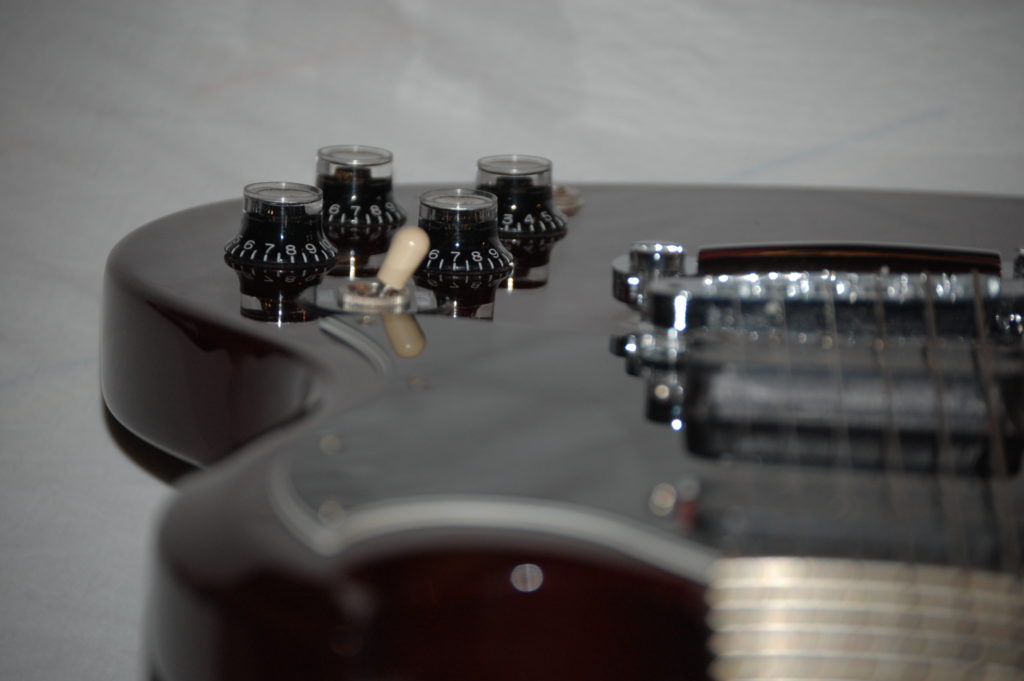

Epiphone EB-0
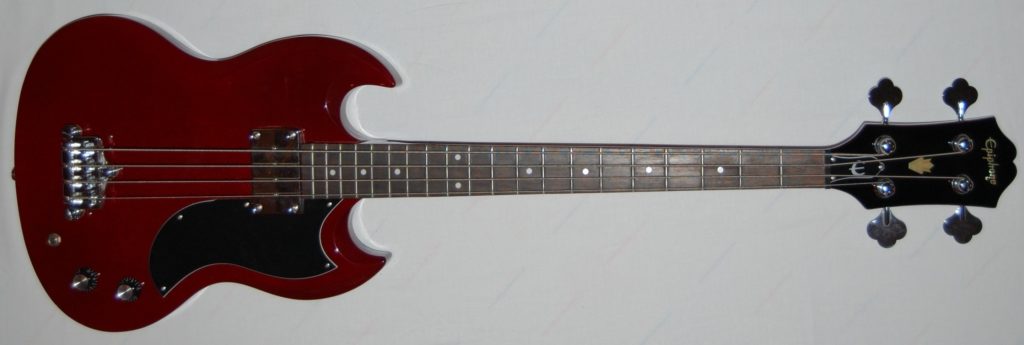
Epiphone EB-0 (2006)
SJ05105776
Mahogany body, one Sidewinder humbucker, volume and tone. Bolt-on neck with rosewood fretboard.
Gibson’s first basses were short-scale (30,5”) with one or two pickups, later changed to standard scale 34’’. Epiphone is making both versions, EB-0 short and EB-3 long.
My bass playing has developed from using the baritone neck on the Dano, to the five-string Falcon, where I never really got to terms with the fifth string. Also, there is something about the humbucker sound, generally. I got the Cream reunion DVD from Royal Albert Hall (I listened to Cream long before I even knew there was a band called Yes) and Jack Bruce never ceases to amaze. Gibson basses all the way.
I already had an SG Special and an Epi 1275 , this could be a sort of family reunion. I had checked one out in a shop, but the decision to buy came a little later when a couple of extra jobs allowed me to. Good, solid sound, and easy to handle.


Gibson ES-135

Gibson ES-135 2001 (2008)
02561891
When three of your favourite guitars are Les Paul, ES-175, and ES-335, and you would like to add vibrato, what could be the answer to this equation?
I would suggest the ES-135. The shape is 175, the thickness is LP, and the centre block is 335. Otherwise it is all standard set-neck Gibson with two humbuckers, two volume and two tone. A Bigsby will fit all three.
Again an eBay find, in a time when buyers seemed to be a little careful. Several items stayed unsold, or minimum bids were not reached. I submitted my maximum plus a little plus a little, and to my surprise I won it.
We hit it off at first play. But as hinted I had a devious plan ready: I had been getting friendly with the Strat “tremolo”, the Steinberger divebombing unit, and the licenced Bigsby on the Ibanez Artcore. Three different units, and the Bigsby version was something I would like to explore further. I wanted to combine a screwed down bridge and a Bigsby. All due respect to the Artcore, but there was something not right with the floating bridge. I got myself a Bigsby B7, and exchanged the stoptail for a screwed down chunk of metal and spring. Sacrilegious? I think not, as Les Paul has never left any guitar unmodded, including his own signature model, and Leo Fender practically invented the upgradeable guitar.
Modification thereby deemed acceptable by the two gentlemen, and the resulting Bigsby ES-135 could easily be a contender for The One if I had to make the choice. Fortunately I don’t have to.





Gibson ES-125

Gibson ES-125D 1957 (2009)
U3071 34
Full-size laminated body, no cutaway, two P90s and standard control layout.
Produced 1941 to 1971, the various editions featured one or two pickups cutaway or non-cutaway, full-body or thinline. It seems this version vas produced in a limited number only in 1957.
Antiques are desirable. They don’t make Ming vases like they used to. But guitars? In most circumstances better production techniques, CAD/CAM and stricter standards ensure better quality, and a new and pristine car/computer/washing machine is the thing to desire.
Then again, sometime in the late sixties the leading guitarists of the day found that Gibson Les Pauls made in 1958, 59 or 1960 had a sound like nothing heard before. Used is the new new. And things escalated.
I would like a 1959 Les Paul. Both because of the connection my musical heroes, and because 1959 is a special year. The sad thing is, I would have to sell everything else and the house to be able to get one. So no, sorry. A 1973 with a different brand logo on the headstock will have to be it.
Or a new LP with a «50’s neck» is probably closer. And a Melody Maker, introduced in 1959, is sort of connected to that year.
I did not settle with those. I have experienced the fifties, or at least ten and a half months of that decade, although I remember nothing of it. My first recollection of the idea of years was when somebody told me it was nineteen sixty-three. I was almost four.
In 2009 I turned fifty, and I decided to celebrate by inviting a fellow fifties full-bodied slightly cracked voice to the party and into the family. Two years older than me, I like the thought of this one existing even when I didn’t, and the thought of these beauties surviving me doesn’t scare me, either.
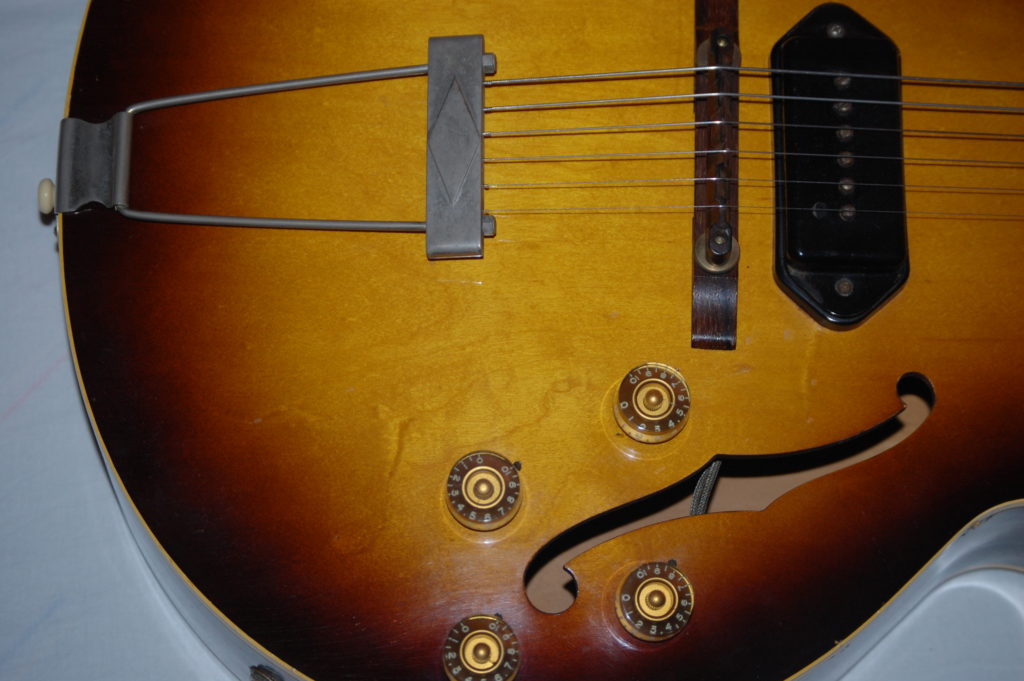




Gibson Les Paul Recording

Gibson Les Paul Recording 1972 (2012)
738098
Pancake body, low-impedance pickups and an array of switches.
Les Paul could be an even greater tinkerer than Leo Fender. The story of his contribution to the development of the Les Paul Model changes with the teller, but when the man himself got his hands on the production models, he usually got to work with screwdrivers and soldering iron. For clean sounds he preferred the low-impedance pickups, and a Bigsby and this strange Les Paulverizer contraption was added as well to his personal guitar. Gibson picked up on his mods and released the Les Paul Personal in 1969. It even had a swan-neck microphone attached for talking between songs. Next came the Professional, sans microphone but with the same switches. The third and more popular version was the Recording (1971) with an even more comprehensive switchboard.
I remember seeing the cool Ibanez version with the slanted pickups in advertising in 1973; I even got a full Ibanez collection poster from Imerslund and put it on my wall. The next time I came across a mentioning of the Recording was on the gatefold sleeve of Steve Howes album The Steve Howe Album. Still looking (and sounding) cool. I would have liked one.
There was an unexpected influx of money in the spring of 2012, opening for a new Dell computer, new Dali stereo speakers, and a new Gibson. I would like one! I immediately committed the heresy of screwing down a Bigsby in the mahogany top of a vintage guitar, but Lester himself had done the same, so no bad conscience. Worked well, but I had second thoughts some years later and removed it again.
In a Burning Building scenario this would be one of the first to consider. There is something about the weighty feel, the played-in neck, the incredible clean sounds, and how it wakes up and roars with some overdrive and reverb/delay. This is the sound and the versatility I’ve been looking for.
I am no stranger to art exhibitions, I have even contributed to a few openings, and in the summer of 2012 the art organisation Bølgeblikk (untranslatable. Literally “corrugated iron” but could be “wave view” or something equally poetic) needed some music. Pia Marie Hansen, on vocals and shaker eggs, and I performed two cover songs and my own Warmer Welcome to the warmer sounds of the Recording.

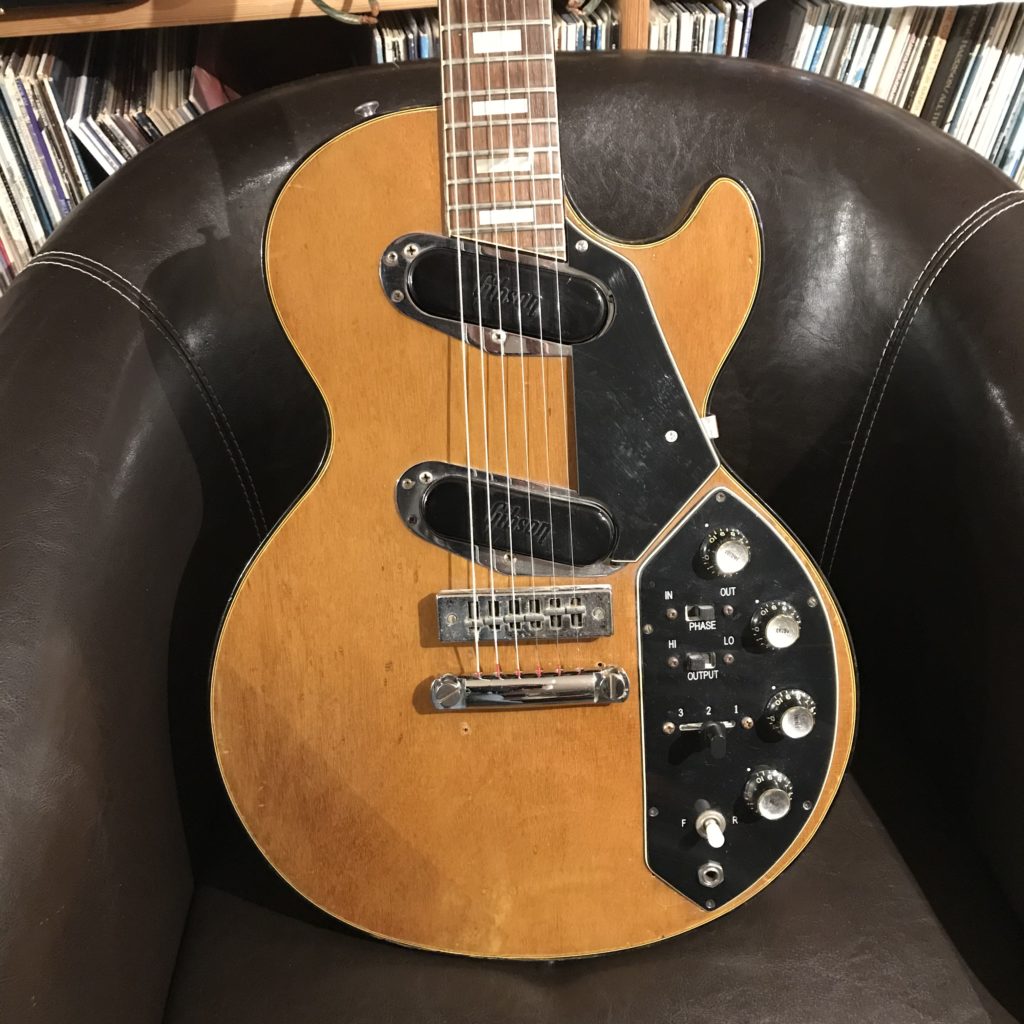



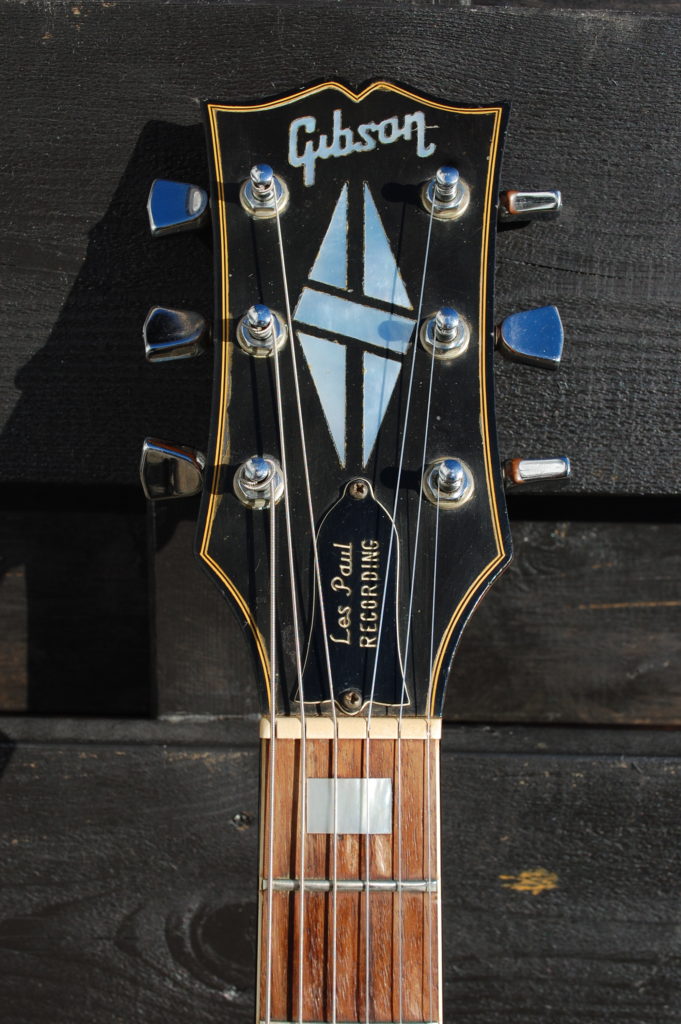
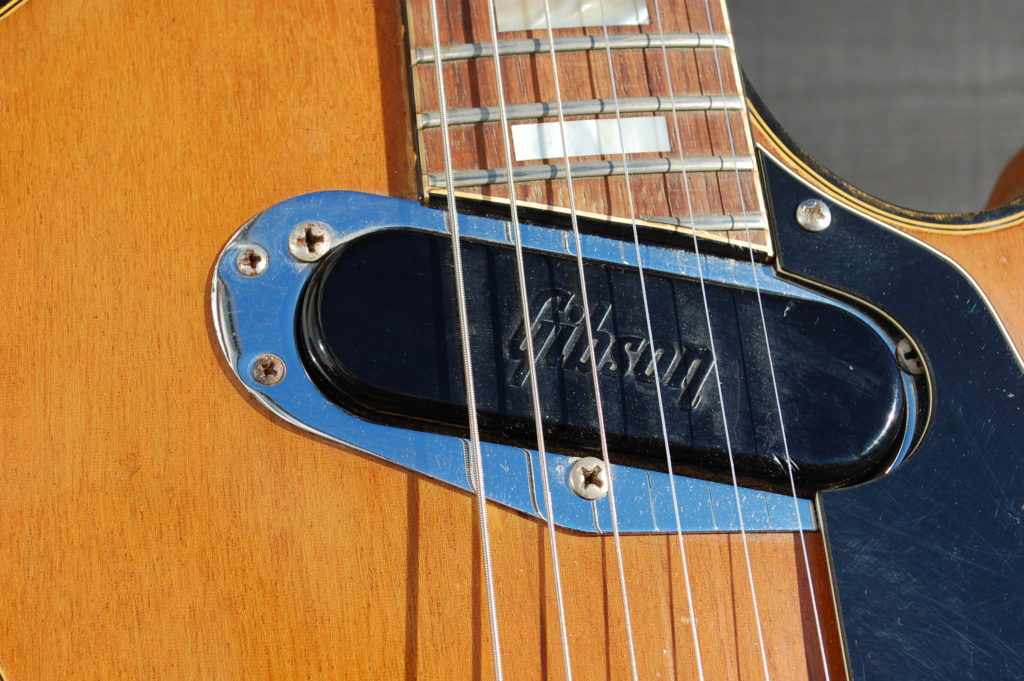
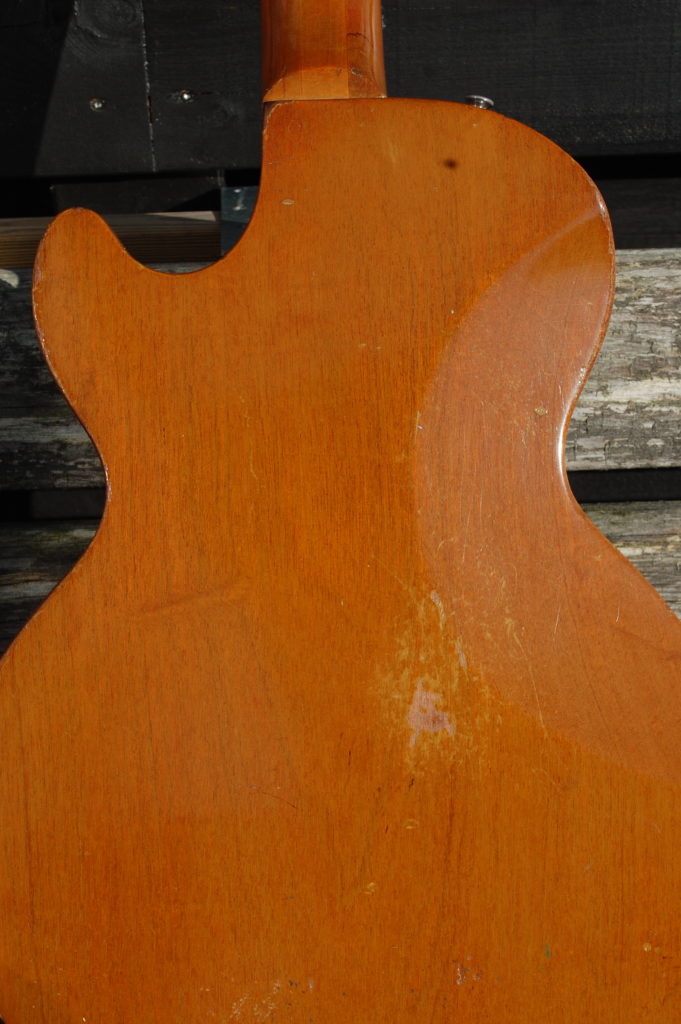

Gibson ES-175

ibson ES-175 2001 (2015)
Full-thickness body made of laminated maple, Florentine cutaway, two ‘buckers and the proper controls. The one Steve Howe plays.
The Epi Emperor was a precursor, as was the ES-135. This is the state-of-the-art working tool for jazz guitarists, and for prog inventors who tend to slip between the labels.
There is no story here, other than the anticipation rising as I committed to buy, and the excitement as I opened first the cardboard wrapping and then the luxurious Gibson case to reveal this. The stories will develop in the playing.







Gibson ES-345

Gibson ES-345 1976 (2015)
00 105127
Thinline hollowbody with solid maple centre block, set neck and trapeze tailpiece, two humbuckers with stereo output, two volume two tone, and the six-way Varitone switch dividing opinions.
Introduced in 1959 as an upscale version of the ES-335, it has off and on been part of the important invention of Gibson’s: The semi-solid. Less prone to feedback than the full-size jazz boxes, and with more sustain, it also adds the air and resonance to the tone.
There are plenty of reasons to own a 345. Personally, the fact that this model weas presented in February 1959 at the same time as this writer, weighs heavily. Another reason is the classic Yes album Close to the Edge. Steve plays a 1972 345 throughout, demonstrating both his skills and the versatility of this model. So when this came up on eBay, and the financial situation could match it, there was no hesitation.
I have yet to try out the stereo output in full (front to one side, back to the other, with different effect settings), but I like the Varitone. What exactly it is doing is beyond me; I listen with my ears and not with a voltmeter.
The sounds go from cool jazz to insistent prog, and that is even before stepping on any pedals (except compression and reverb, these are always on). Even unplugged it has its clear voice, perfect for practising. As I am into the master/acolyte connections, there are a couple of Made-in-Japan 330 copies to complete this small group of thinlines with round ears. To be exact, in 2024 I acquired a Greco version of this model to be viewed on the Apprentices page.
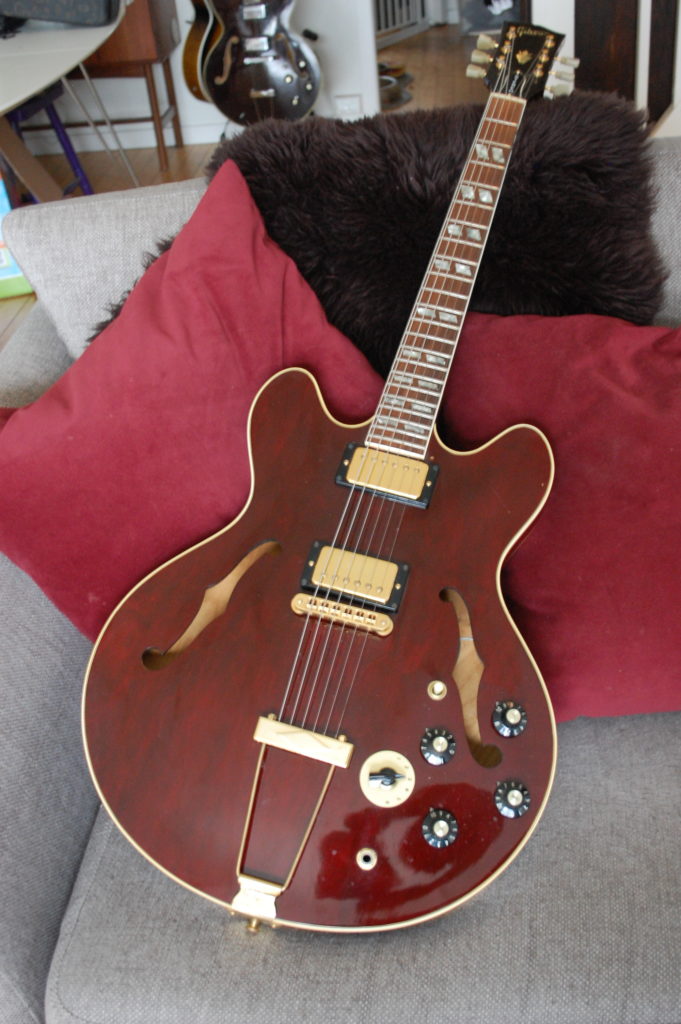






Gibson Les Paul Deluxe

Gibson Les Paul Deluxe 1976 (2022)
00 130593
Classic Les Paul layout, but with the surplus mini humbuckers from the Epiphone takeover. Worked very well, even though the idea of reissuing something that never was, was slightly off centre.
Sort of returning to the early Seventies and my first encounter with a Gibson. At last. This is a weighty piece, but some burdens are easy to carry. The feel is very Gibson, very Les Paul the way quality shows. Three-piece neck and pancake body is, in my opinion, a foundation for stability. Soundwise, the minis sound more articulated, still retaining the desired ‘bucker sound and cuts through some over-eager keyboard playing.
Thanks to the Japanese provider who even bothered to greet me in Norwegian!








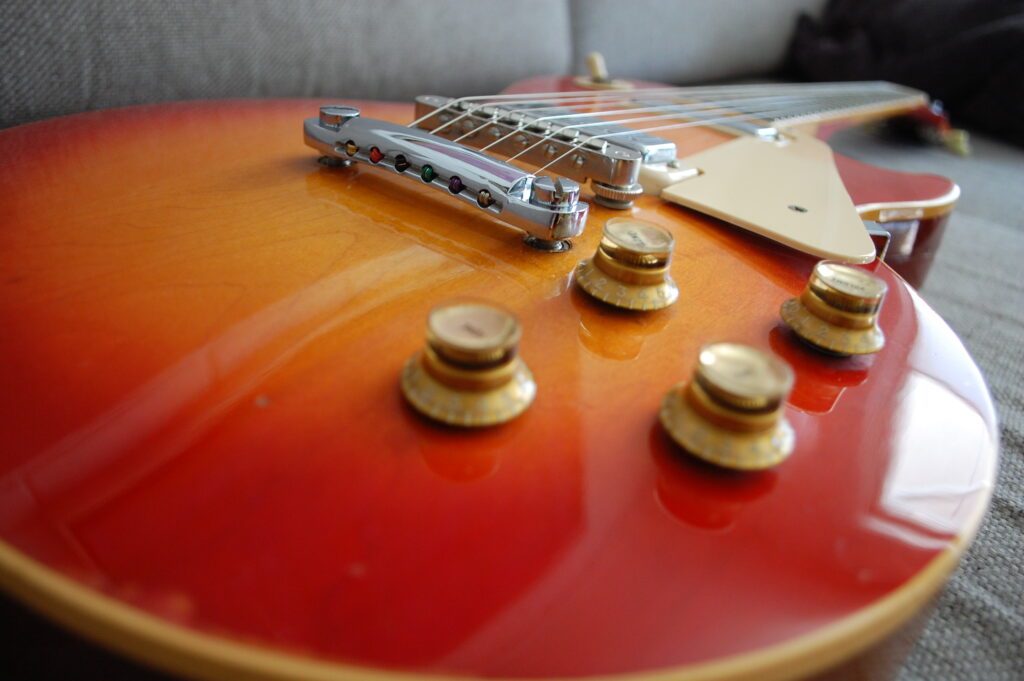
Gibson ES-335
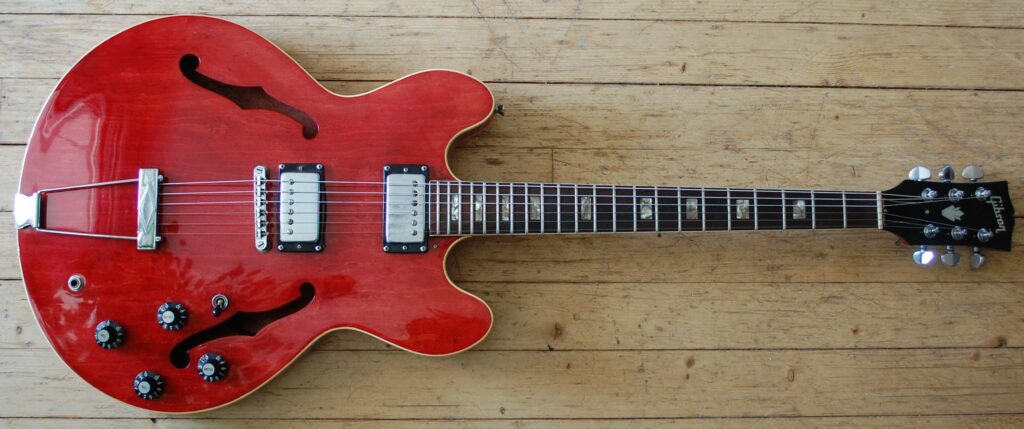
Gibson ES-335TD Block 1972 (2023)
929586
The search for the Seventies feeling never stops. When a ’72 turned up on eBay I couldn’t resist. Maybe not the best of times at the Gibson factory, but they could produce good instruments even though the Fuji-Gen people were breathing down their necks. Even with new machine heads and other upgrades, probably a refin too, this beauty pleaded for room in my collection. Room provided after an unnamed Postal Service failed to bring it to my doorstep and it was returned to seller; in the second attempt the UPS put it just there when I was unsuspectingly walking the dog.
My modifications consisted of removing the pickguard and replacing the knobs.
There is always this moment when plugging in for the first time; I was not disappointed.







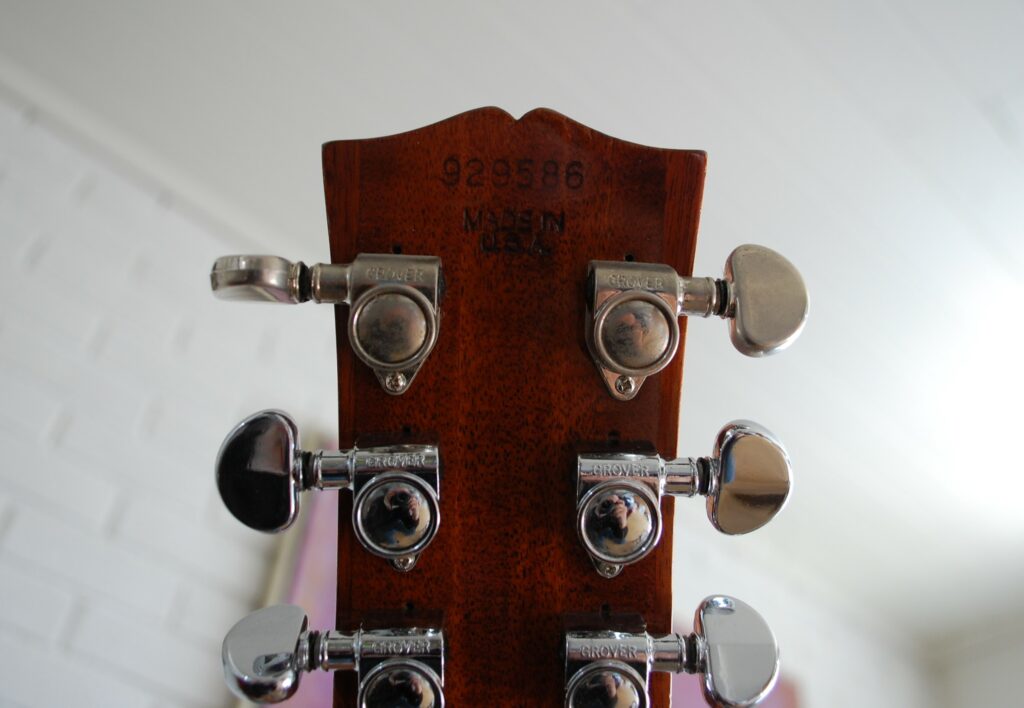

Gibson Les Paul Junior

Gibson Les Paul Junior 2020 (2023)
201310064
Wrapover bridge, one P90 with volume and tone. The basics. Introduced in 1953 to appeal to students and those who didn’t necessarily want the fancy colour and bindings of the Goldtop. On this recreation of the original, the pickup sits close to the neck – it was moved further away in 1956 to smoothen the treble sound. Look to the copy presented elsewhere for newer pickup placement.
The quest for a Junior, part four. See The Escapees and The Apprentices for the story. Finally the right-looking model turned up; a recent Historic Collection version that looked exactly like the original, and pristine at that. And yes, the sound is spot-on. As much as I like the flexibility of the knobs and switches on the Recording, there is also The One Sound of a one-pickup guitar. Listen, fingers: Tone is now your responsibility!


Orville Les Paul Custom
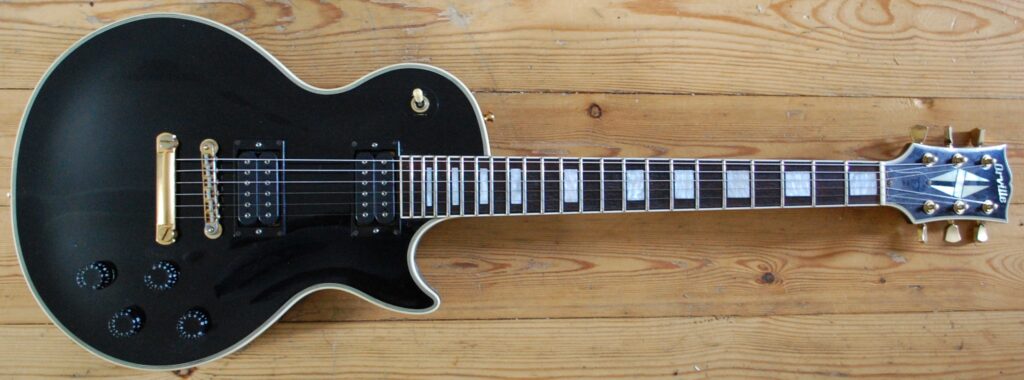
Orville Les Paul LPC-75 1995 (2023)
502197
Classic Les Paul construction and layout. It seems this is all-mahogany like the original; research is ongoing. Multi-ply binding and block inlays, split-diamond headstock inlay.
Faithful Japanese-made version of the high-end Custom model introduced in 1954 and upgraded with humbuckers in 1957. This one was made in the Fuji-Gen factory which is also responsible for both Ibanez and Squier branded guitars. It all comes together, it seems.
Orville is Mr Gibson’s given name. It is also Gibson’s Japanese-made brand from 1985, in the same way Fender licenced production under the Squier name.
The serial number means 1995, February, production number 197.
Black Beauty or Fretless Wonder, this is an affordable take on Les Paul’s tuxedo accessory. I believe he said «you can see my hands flying». I’ll practice.
This one from 1995 has been upgraded with DiMarzios. Great sounds. Where did I put my bow tie?








Gibson ES Artist

Gibson ES Artist 1979 (2023)
73339014
Maple thinline body, no f-holes. Two humbuckers, and then comes the oddities: Master volume, and master bass and treble tone, and three switches for treble boost, limiter, and compressor. Impressive circuit board courtesy of Dr. Robert Moog (of synthesizer fame) behind the back plate.
This model is playing a big role in Asia. No, not the continent, but the band; formed by Steve Howe, Geoff Downes, Carl Palmer and John Wetton in 1981. Like Yes, there were numerous lineup changes, but when Steve was in, his four ES Artists were present too.
I tried one some years ago, and finally found one on eBay. The sound leaped out at me, with a clarity, definition and attack even before the switches were activated. The breakup when the treble boost is on gives just the right edge.
And to prove I’m not copying everything Mr Howe is doing: He put extra pickguards on his, I removed the one on mine, as I tend to do. I like the unbroken maple landscape dressed in sunburst.








Gibson Les Paul Standard

Gibson Les Paul Standard Sunburst with aftermarket Bigsby 1977 (2024)
00 237706
The standard, according to Gibson: Set neck, two humbuckers, separate volume and tone, three-way switch. 70s pancake body. Heavy.
Found on the website of No.Tom Guitars in Denmark Street. Test before you buy, they say, so I went to London to try it out.
Or the other way around. I went to see the current incarnation of Yes (featuring a certain Mr. Howe) in Royal Albert Hall, and preparation for the trip included browsing websites of purveyors in the vicinity. Again I was drawn to this very friendly shop, and I quickly browsed around in a couple of other establishments before entering the place that had so willingly provided me with a ’78 black Strat the previous year. Play, decide, and arrange for shipment as I am not too trusting of baggage handlers at airports. Exactly two weeks later it arrived on my doorstep, in pristine naturally relic’d condition.
In the seventies I dreamt of a Les Paul Standard sunburst. In 2006 I got one. But as I was drawn more and more towards the genuine 70s articles, I decided to pass the 2005 on, along with the 2019 Goldtop. That deal got me two great additions to my amp collection; that story is on another page.
So how does this one rate? Love at first grip of the well-worn neck and at the first burst of sound from the ‘buckers. Pairing extremely well with the Twin Reverb now sitting between pedal board and mixer.







Gibson Les Paul Goldtop

Gibson Les Paul Deluxe Gold Top 1975 (2024)
00 223438
Just like the first Gibson I ever played.



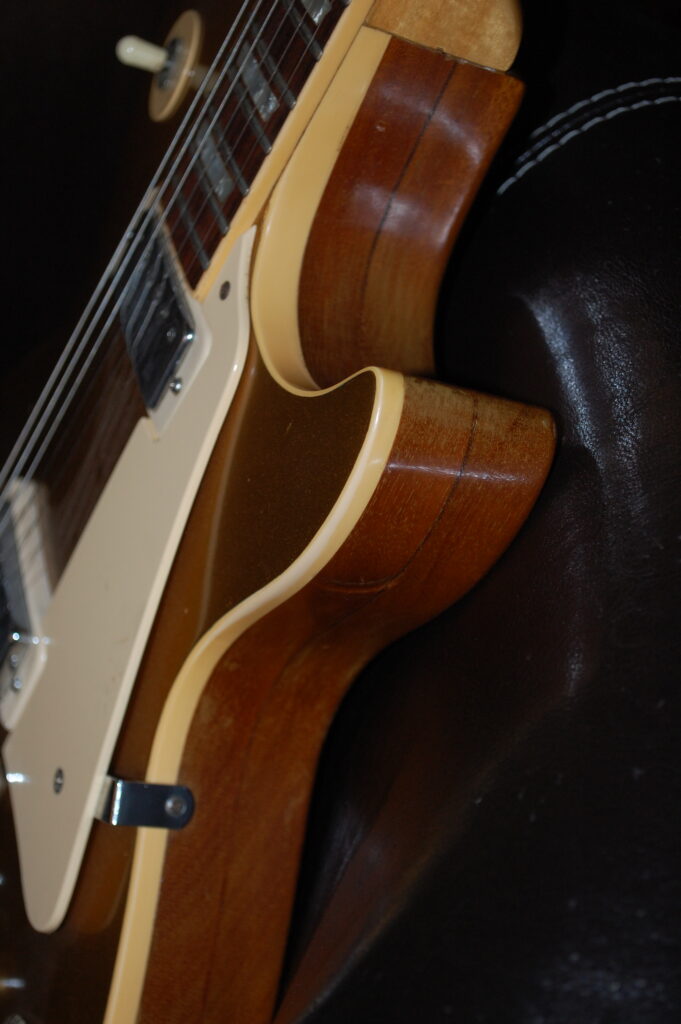

Gibson ES-335

Gibson ES-335 Pro 1979 (2024)
A 335 by any other name… could be the short-lived Pro, made from 1979 to 1981. A rockier version of the versatile semi-hollow, featuring Dirty Fingers open-coil humbuckers. Apparently some of these were controlled by one tone only along with the two volumes; this is the classic setup. Stamped Seconds on the back of the headstock, I am not sure what this refers to. Marks of use all over gives it a great played-in feel, and yes, these pickups rock when compared to the ’72. Stoptail may also have to do with defining the sound. If I had to pick one… I’d just put the other back on the stand.



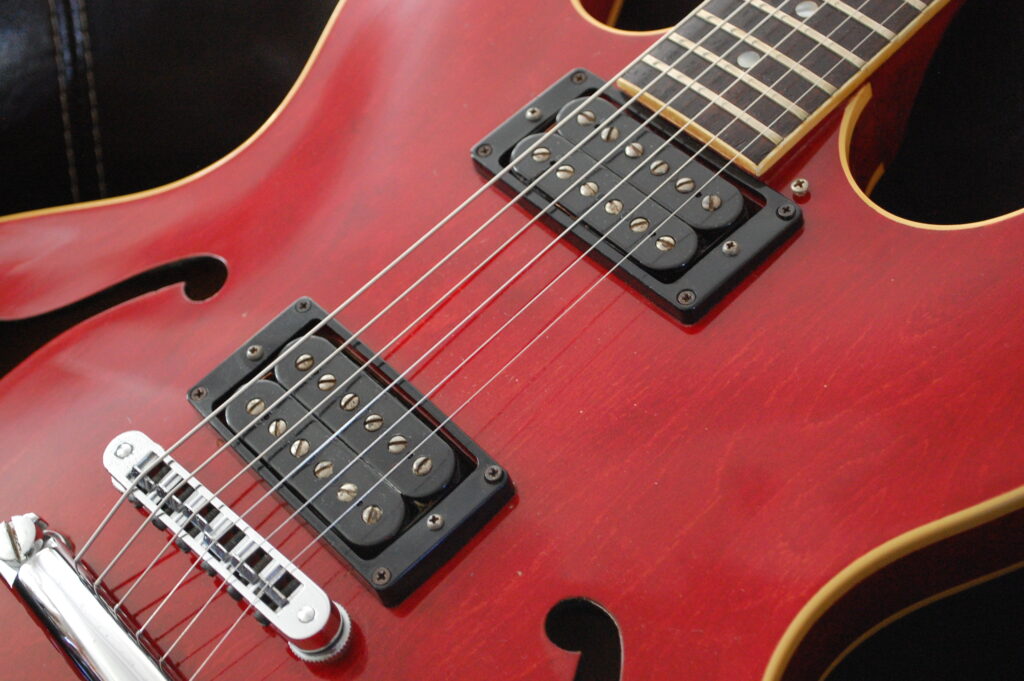

Gibson galleries


A trio of SGs: Gibson SG Special, Epi EB-0, and Epi 1275




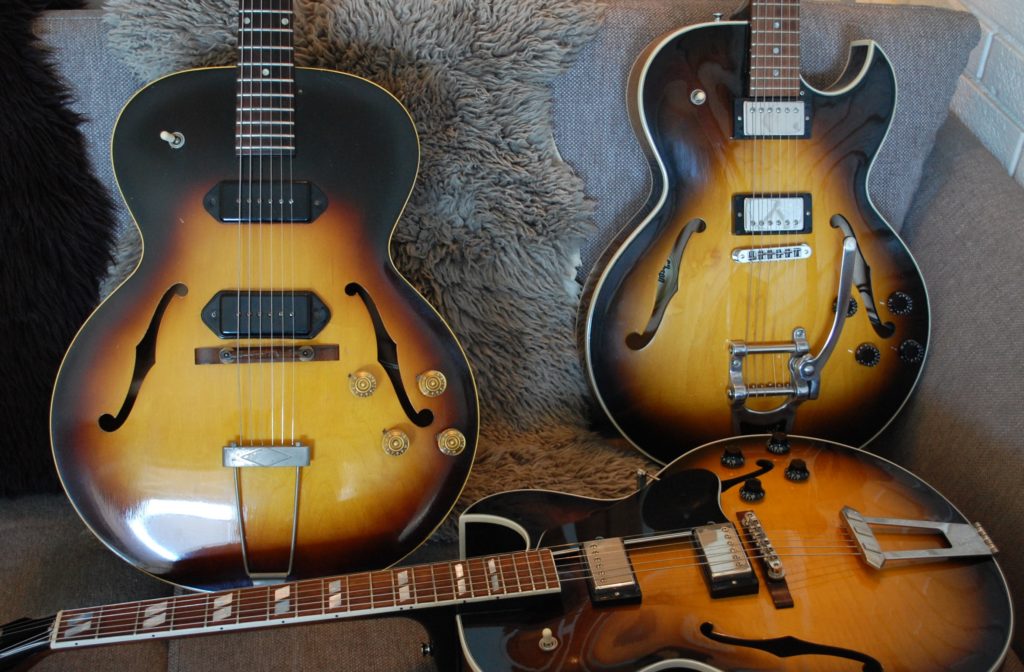

Three Sunburst Gibson jazz boxes, with variations. 1957 ES-125 with full body and P90’s, ES-175 with full body and humbuckers, ES-135 with humbuckers, centre block and Bigsby.
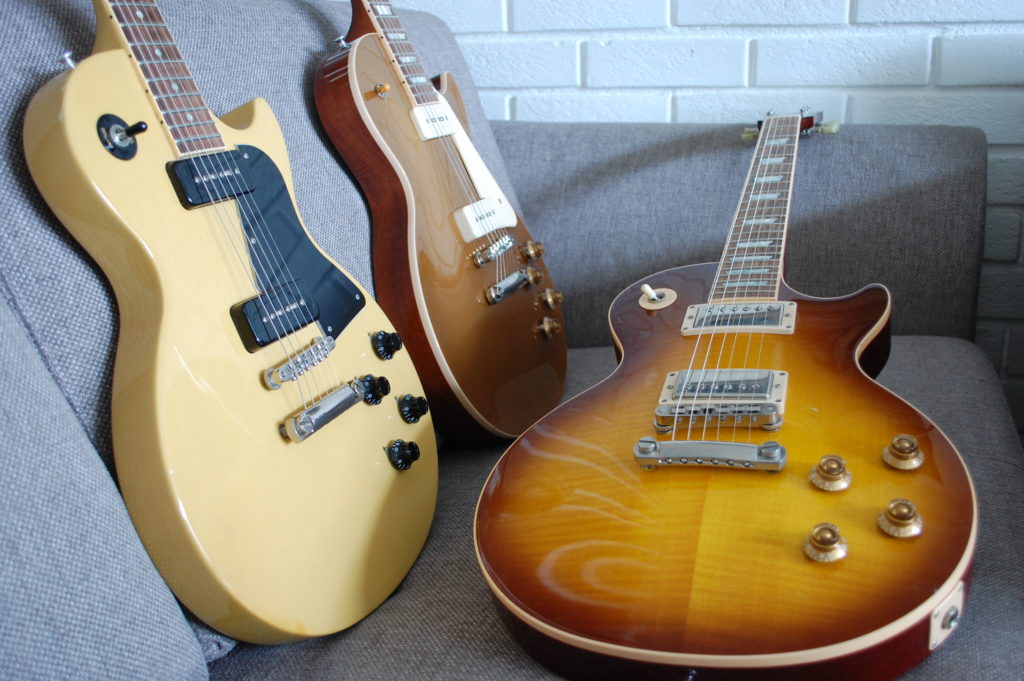




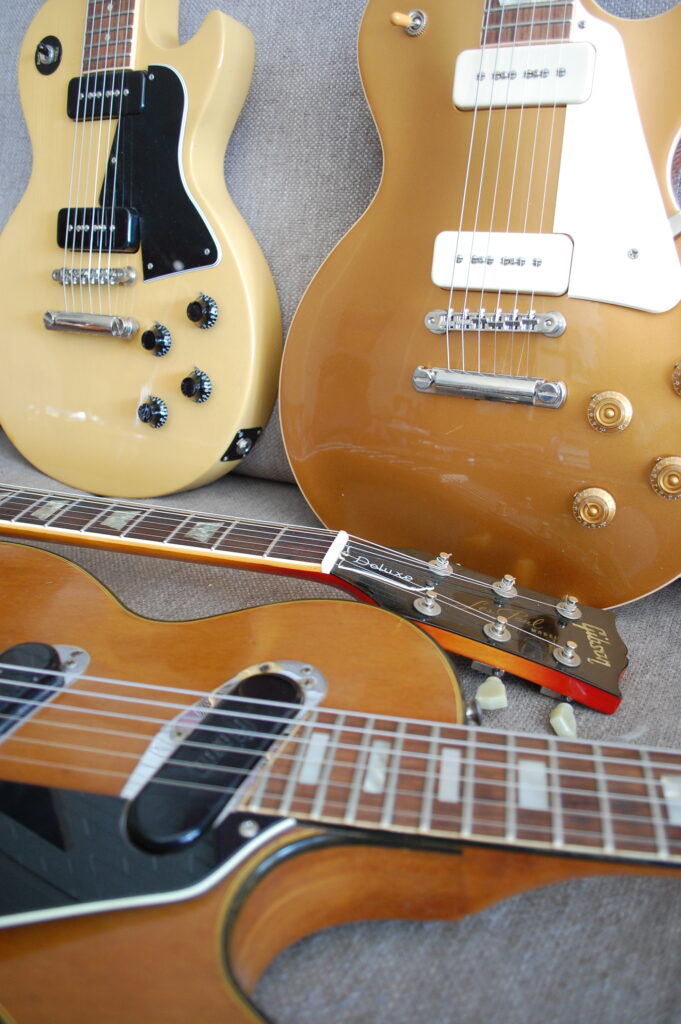




Six Lesters: 1976 Deluxe, Standard Sunburst with 50’s neck, 1973 Recording, Goldtop with 1956 specs, modernized Special with P100s, Junior.




Three with P90s. (Or close. The Special has P100s, but they look right.) Dogears on the ES-125.


Two sunbursts: Les Paul Deluxe 1976 and a modern take on the Standard from 2005.
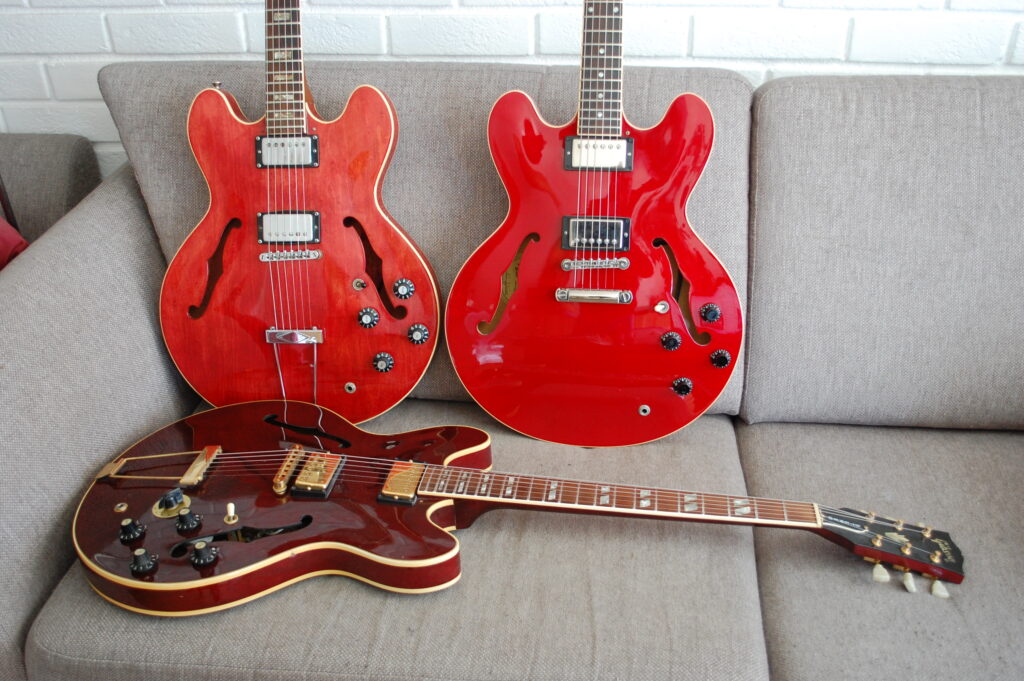


The 335 family: 1972 335 Block, 2001 335 Dot, 1976 345.
Tour
Keep going; tour part 5: